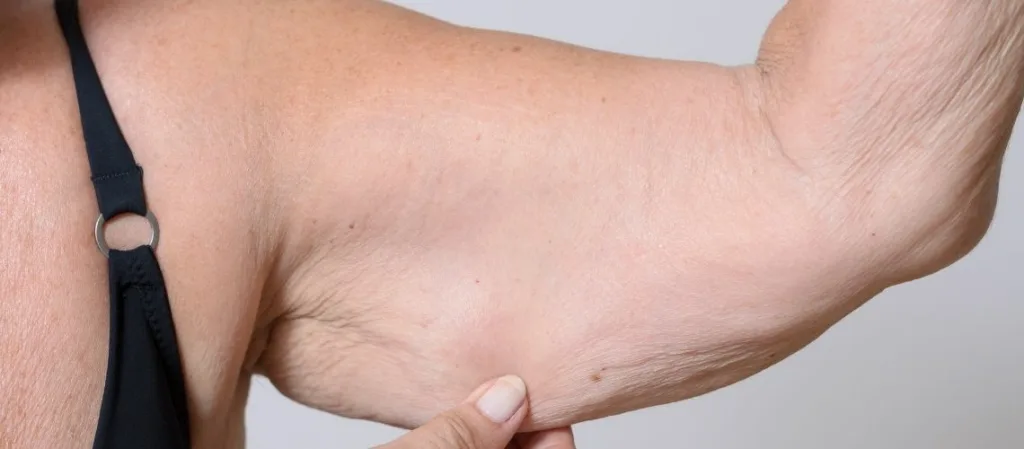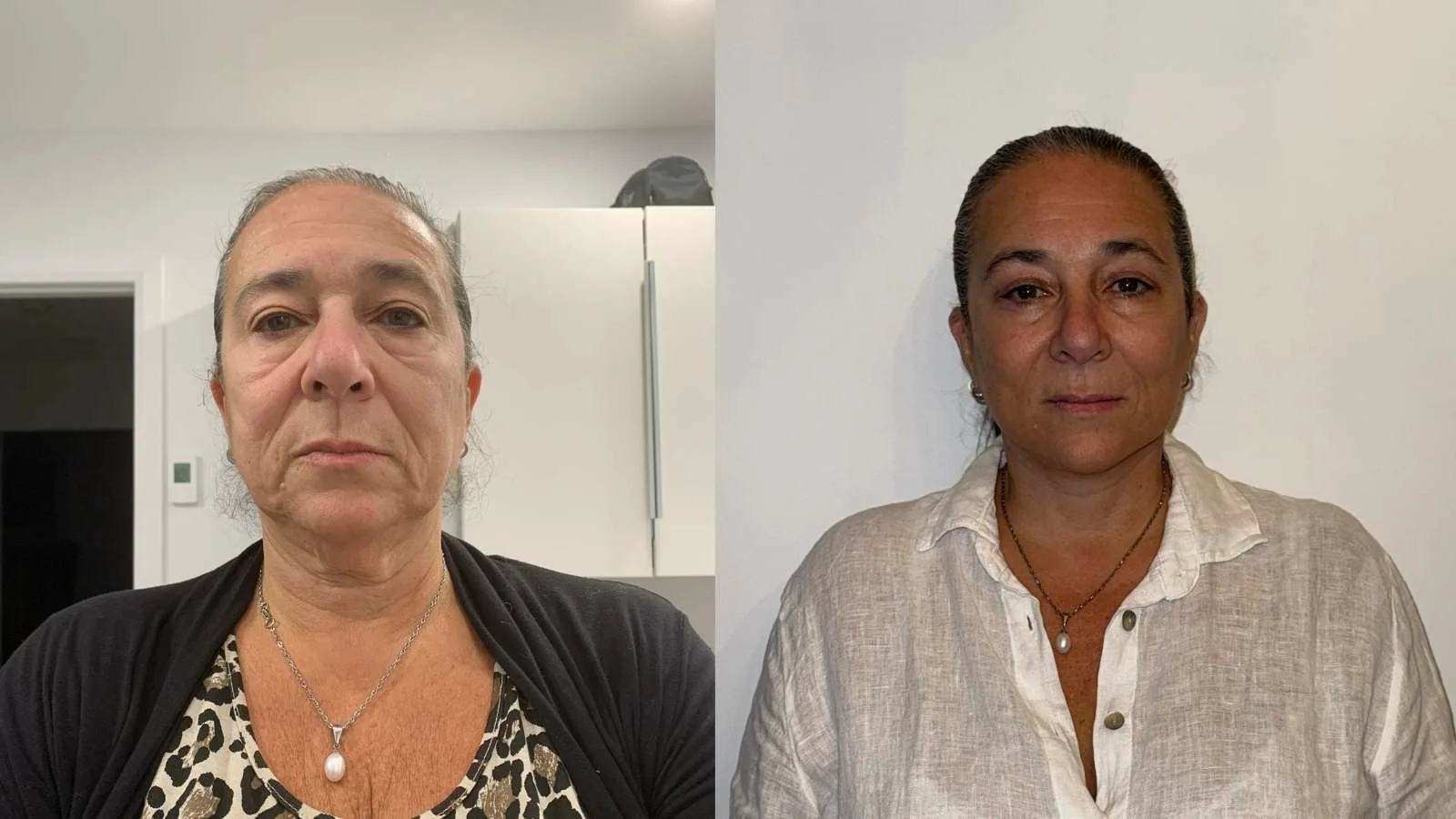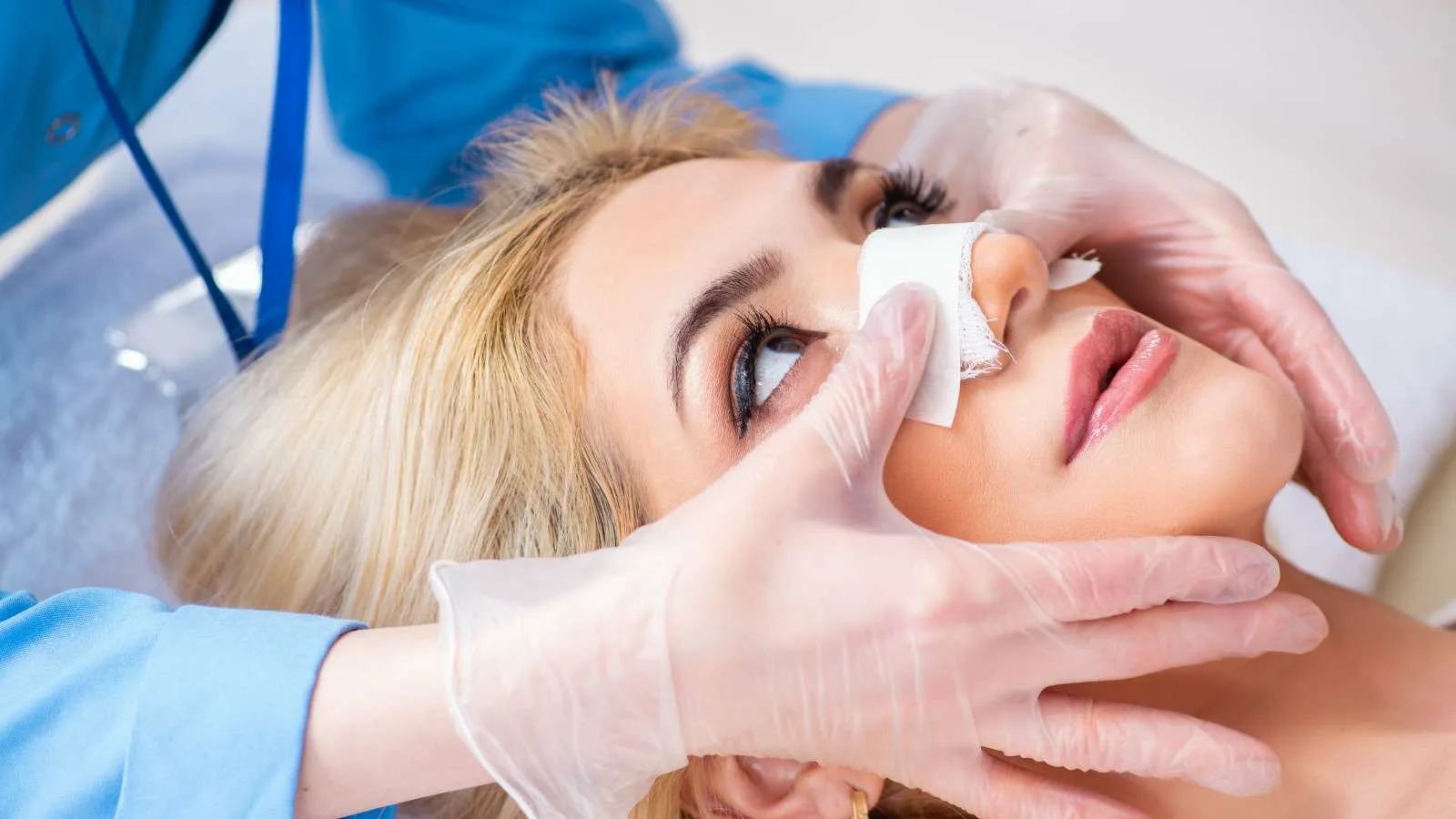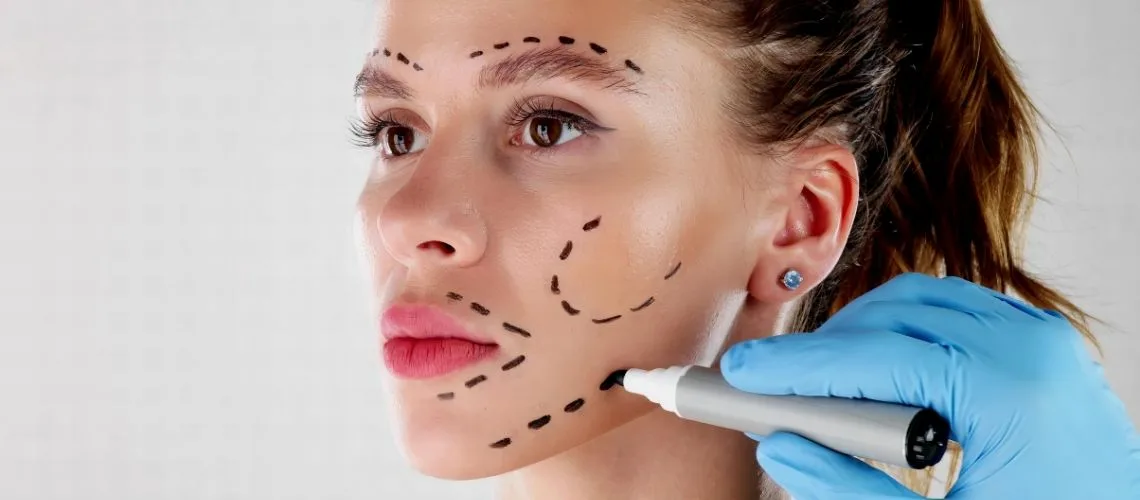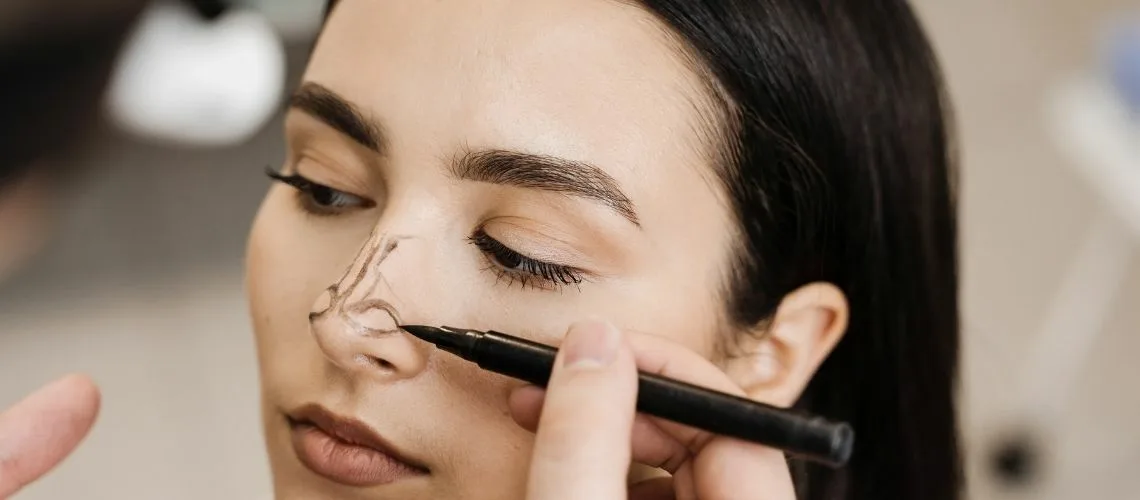Sagging skin rarely recovers by itself once collagen and elastin fibers are significantly damaged. Preventive measures and early interventions are key to maintaining skin firmness and elasticity over time.
Healthy lifestyle habits, such as balanced nutrition and adequate hydration, support skin integrity. Antioxidant-rich foods and sufficient protein intake help preserve collagen structure and slow down sagging.
Sun protection plays a critical role in prevention. Regular use of sunscreen reduces UV-induced collagen breakdown and helps maintain skin’s youthful resilience.
Non-surgical treatments like radiofrequency or ultrasound therapy can stimulate collagen production. Combined with preventive care, these methods delay progression and improve skin tightness without surgery.
Why Does the Skin Sag?
There are multiple factors behind skin sagging. These can be divided into internal (natural aging) and external (sunlight, environmental pollution, lifestyle, etc.) factors.
- Decrease in Collagen and Elastin Levels
Collagen and elastin are proteins found in the lower layers of the skin, providing elasticity and firmness. As we age, collagen production may decrease by about 1% each year. Although this rate seems small, it plays a major role in the long-term reduction of the skin’s tension. Elastin similarly breaks down over time and loses its function. The result is that the skin’s ability to recover decreases, leading to a looser appearance.
- Cellular Aging and Genetic Factors
The capacity of cells to divide is related to “telomeres” at the ends of the DNA. As telomeres shorten over time, the regenerative ability of cells decreases, and signs of skin aging increase. If there is a family history of early sagging and wrinkling, this can be genetically passed on to future generations.
- Hormonal Changes
During menopause, the drop in estrogen levels reduces the skin’s ability to retain moisture. Similarly, the decrease in testosterone during andropause in men can also lead to changes in the skin. Hormonal fluctuations can trigger dryness, thinning, and a tendency to sag.
- Environmental Factors
Ultraviolet (UV) rays, cigarette smoke, air pollution, and even unhealthy eating habits cause an increase in free radicals in the body. Free radicals damage the structural proteins of the skin, accelerating the sagging process.
- Weight Fluctuations
As the body’s fat ratio increases or decreases, the skin first stretches and then tries to return to its original state, like a stretched-out elastic band. However, this rebound is not always complete. Especially rapid weight loss can create a space under the skin, leading to sagging.
All these factors combine to weaken the skin’s fundamental structure and eventually lead to sagging. The real question is how much the skin can recover on its own.
Can Sagging Skin Actually Tighten on Its Own?
Our body has an incredible healing potential designed to repair many types of damage, from small injuries to significant traumas. When it comes to the skin specifically, this potential varies depending on age and circumstances. For example, someone in their 20s has skin that is much richer in collagen and elastin; thus, it can more easily repair minor damage and looseness. But once you reach your 40s or 50s, the pace and quality of skin repair slow down.
- Mild Sagging: This is often seen in younger ages or early middle age, where the skin can easily recover thanks to collagen support. For instance, after short-term weight gain, the skin may spontaneously tighten itself once the weight is lost.
- Moderate Sagging: Here, the looseness is noticeably visible. Starting an exercise routine, eating a proper diet, and taking care of the skin can help improve the situation but may not fully restore it to its original state.
- Severe Sagging: Often seen in prolonged obesity or older adults, this may appear as deep folds in the skin. In such cases, surgical interventions or strong medical device treatments might be necessary.
Although the skin has a certain capacity to recover, it is often not possible for severely lax skin to become fully tight without any intervention. Therefore, early prevention is extremely important.
How Do Hormonal Changes Affect the Skin?
Our body functions like an orchestra in harmony, with hormones maintaining the balance. Estrogen, testosterone, and thyroid hormones, among others, play a role in the skin’s firmness.
- The Role of Estrogen: In women, there is a notable drop in estrogen levels during menopause. Estrogen supports the skin’s ability to retain moisture and collagen production. As this hormone decreases, the skin becomes thinner and drier, and the likelihood of sagging increases.
- The Role of Testosterone: Present in both men and women, this hormone supports not only muscle mass but also the general structure of the skin. As we age and testosterone levels decrease, the skin may lose elasticity.
- Thyroid Hormones: Insufficient or excessive thyroid hormones can cause the skin to become dry, thin, or even swollen. Both extremes negatively affect skin quality.
When the balance of these hormones is disturbed, the effects on the skin can be clearly observed. If you notice sudden changes in the skin, it may be worthwhile to check for an underlying hormonal issue. In necessary cases, medical intervention to regulate hormone levels can slow down the progression of sagging.
What Should You Do to Prevent Skin Sagging?
Although sometimes sagging may seem unavoidable, it is possible to significantly slow this process by paying attention to your lifestyle and applying a few basic principles.
- Balanced Nutrition:
Foods high in antioxidant capacity (vitamins C, E, beta-carotene, zinc, selenium, etc.) help protect skin cells from damage caused by free radicals. In contrast, processed foods, excessive sugar intake, and ready-to-eat items cause “glycation,” a process in which sugar binds to collagen and elastin fibers, making them stiff and contributing to sagging.
Analogy Example: If we compare collagen fibers to rubber bands, sugar stiffens these rubber bands, making them more brittle. On the other hand, a diet rich in antioxidants helps keep these rubber bands flexible and strong.
- Regular Exercise:
Especially resistance training can support the skin from the inside by increasing muscle mass. As muscles strengthen, the skin can appear tighter. Aerobic exercises also speed up blood circulation, delivering more oxygen and nutrients to the skin.
- Adequate Sleep:
Sleep is when the skin’s repair and renewal processes are most intense. Growth hormone is secreted during nighttime sleep, which positively affects collagen synthesis.
- Avoid Stress:
Stress raises the body’s cortisol level. Chronically high cortisol can reduce collagen production. Especially with prolonged stress, the skin becomes dull, thinner, and over time more prone to sagging.
- Protect from the Sun:
UV rays break down collagen and elastin fibers. Using sunscreen products and protective clothing throughout the year, along with avoiding excessive sun exposure—especially between 10:00 AM and 4:00 PM—is a crucial step in preventing skin sagging.
These are the essential lifestyle approaches to delay sagging. The key is to adopt these habits as a sustainable lifestyle rather than a “short-term diet.”
What Role Does the Sun Play in Skin Sagging?
Sun-related damage is called “photoaging” and is one of the leading causes of skin sagging. UV rays from the sun penetrate the deeper layers of the skin and directly target collagen and elastin fibers.
- UVB Rays: They affect the top layer of the skin (epidermis), leading to sunburns and contributing to vitamin D synthesis. When exposed excessively, they can cause severe damage and inflammation, which in the long term can trigger sagging.
- UVA Rays: They reach deeper layers of the skin, breaking down collagen and elastin fibers and causing permanent damage. They also affect the skin’s pigment cells, increasing the risk of spots, wrinkles, and sagging.
- Simple but effective measures include using a broad-spectrum sunscreen, wearing a hat and sunglasses, staying in the shade, and avoiding prolonged sun exposure, especially during midday (10:00 AM-4:00 PM).
The negative effects of the sun on the skin lessen as you reduce sun exposure time and use protective products. This is crucial not only for sagging but also for the risk of skin cancer.
How Do Weight Changes Affect Skin Health?
Rapid weight gain and loss are similar to continuously inflating and deflating a tight balloon for the skin. In younger years, the skin is more elastic, so it can handle these fluctuations relatively easily. However, as we age, each rapid weight change reduces the skin’s elasticity and can lead to permanent sagging issues.
- Rapid Weight Loss and Sagging:
Significant weight loss is especially common among those who have undergone obesity surgery. When the skin has been significantly stretched, it may struggle to conform completely to the suddenly slimmer body. Not just the abdomen but areas like the arms, legs, and face are also at risk of sagging.
- Slow and Steady Weight Loss:
This is considered a healthier method. The skin needs time to adjust. During this process, regular muscle-building exercises enhance the subcutaneous tissue by increasing muscle mass, helping to keep the skin plumper underneath.
- The Importance of Weight Maintenance:
Maintaining an ideal, stable weight rather than frequent weight fluctuations is one of the most important factors in supporting skin health over the long term.
Nevertheless, in some cases, surgical interventions (such as a tummy tuck or arm lift) may be considered to remove excess skin. This varies from person to person and requires medical evaluation.
Which Skin Care Products Are Effective?
There are many products on the market that promise to “instantly tighten the skin,” leading people to wonder which ones truly work. According to scientific research, certain ingredients are quite effective in promoting collagen production, moisturizing the skin, and providing antioxidant protection.
- Retinoids (Retinol, Tretinoin, etc.):
Retinoids are vitamin A derivatives that speed up cell renewal and increase collagen synthesis. With regular use, they can reduce the appearance of fine lines and mild sagging. However, keep in mind that these products may cause mild peeling or sensitivity in the beginning.
- Peptide-Containing Products:
Peptides, which are short chains of amino acids, can stimulate collagen formation in the skin and help with tightening. In particular, types like “palmitoyl pentapeptide” are used to support the structural proteins of the skin.
- Antioxidants (Vitamin C, E, Ferulic Acid, etc.):
They help protect collagen and elastin by preventing free radical damage. Vitamin C, in particular, also contributes to collagen synthesis.
- Hyaluronic Acid:
By increasing the skin’s moisture retention capacity, it provides a plumper and firmer appearance. Moisture plays a critical role in regulating the intercellular fluid in the skin.
- Sunscreens:
Although they may not seem to have a direct tightening effect, they prevent UV rays—one of the major sources of aging—and thus help reduce sagging in the long run.
Overall, skin care products play a supportive role in mild to moderate sagging. They are usually not expected to be sufficient on their own for severe sagging.
What Role Do Diet and Hydration Play?
Proper nutrition and adequate hydration strengthen the skin from within. A nutrient-rich diet supports the production of the building blocks of skin cells.
- Protein Intake: The skin’s structure, including collagen and elastin, requires protein. Fish, eggs, dairy products, legumes, and healthy seeds (such as quinoa) are good sources of protein.
- Healthy Fats: Omega-3 and omega-6 fatty acids (such as salmon, avocado, walnuts) help strengthen the skin barrier and maintain elasticity.
- Antioxidant Sources: Colorful fruits and vegetables, tea (especially green tea), cocoa, tomatoes, and pomegranate reduce the body’s free radical load.
- Adequate Water Intake: Water is critical for skin cells to maintain their structure. If someone does not drink enough water, their skin can become dry and dull, making it more prone to sagging.
A nutrient-rich diet positively affects skin renewal. Limiting sugar can also help control the glycation process and protect the structural integrity of proteins in the skin.
Does Exercise Tighten the Skin?
Contrary to popular belief, exercise does not directly target the skin itself but rather the muscle tissue beneath it. Strengthening these muscles can support the skin from within, giving it a tighter appearance. In particular, resistance (weight) training can provide a sort of “internal skeleton,” helping the skin appear firmer.
- Aerobic Exercises (Running, Walking, Swimming): They increase blood circulation and enhance the transport of oxygen and nutrients to tissues, which is crucial for the skin’s self-renewal.
- Resistance Training (Weights, Pilates, Yoga): By increasing muscle mass, these activities shape the body’s overall form. This can be especially helpful in reducing the appearance of loose skin around the abdomen, arms, and legs.
- Facial Exercises: Some people use facial yoga or facial exercises to strengthen the muscles in the cheeks and jaw. While some studies suggest there may be partial benefits, it should be remembered that facial exercises alone are not sufficient to resolve pronounced sagging.
Regular exercise also positively affects hormone balance, helping to prevent and partially improve skin sagging. However, if very rapid weight loss is involved, exercise alone may not be sufficient.
What Are the Surgical Treatments and How Effective Are They?
Although skin sagging can largely be kept under control with healthy lifestyle habits, skin care, and exercise, these methods may be insufficient in some cases. Especially in severe sagging, it is generally difficult for the excess skin to recover without medical intervention. At this point, surgical treatments come into play. Nowadays, these methods focus on different parts of the body to target sagging, helping achieve a tighter and smoother appearance.
Types of Surgical Methods
Surgical interventions can vary depending on the area of sagging and individual needs. Some operations focus on the face and neck area, while others aim to correct excess skin on the abdomen, arms, or legs.
The face is one of the areas where the effects of time are most quickly noticed. Gravity, facial expressions, and the loss of collagen and elastin all contribute to sagging in a wide region—from the cheeks to the jawline and neck.
How Is It Done? The surgeon usually makes incisions around the ears and along the hairline. Then, excess skin is removed, and the underlying muscle and tissue structure is repositioned. After the procedure, the facial contours become tighter and more defined.
Who Is It Suitable For? It is chosen by people with advanced sagging, deep wrinkles, and looseness in the neck area. For mild sagging issues, non-surgical methods may be considered.
This method is especially effective for individuals who, after childbirth or large weight fluctuations, experience a significant amount of excess skin in the abdominal area.
How Is It Done? A horizontal incision is made below the navel to remove excess skin and fat tissue. If necessary, the abdominal muscles are tightened, and the skin is pulled taut and sutured back together.
Who Is It Suitable For? Those who have sagging abdominal skin due to pregnancy, rapid weight changes, or genetic predisposition may consider this procedure.
- Arm Lift (Brachioplasty)
Sagging of the inner side of the arm between the shoulder and elbow can cause self-confidence issues, especially for those who prefer short-sleeved clothing.
How Is It Done? An incision is made along the inner arm, through which excess skin and fat are removed. The skin is then reshaped and tightened.
Who Is It Suitable For? Individuals who experience sagging in the arms following significant weight loss or who have lost elasticity in the under-arm skin due to aging can achieve tighter arms with this operation.
- Thigh Lift
Sagging of the inner thighs over time may not be fully corrected with diet and exercise alone.
How Is It Done? Generally, incisions are made around the groin area or the inner thigh, excess skin is removed, and the thigh area is pulled upward and tightened.
Who Is It Suitable For? It can provide a solution for those whose inner thigh area has become loose, lost elasticity, and developed excess skin.
Effectiveness and Permanence: Is 100% Achievable?
Surgical methods offer the most significant and noticeable results for skin sagging. However, one must remember that aging is a natural process that continues after surgery. Surgical interventions do not “stop time,” but they remove the excess tissue and correct deformations, allowing you to enjoy a tighter look for an extended period.
- Longevity of the Results
Results are generally considered permanent. For example, after a tummy tuck, if an individual maintains a healthy diet and exercises regularly, the abdomen can remain tight for many years. However, major weight fluctuations or pregnancy can increase the risk of sagging again.
- Aging Effect
Surgical intervention does not slow the rate of aging; it simply addresses the current excess and deformation. In subsequent years, there may be some loosening or sagging, but it will be far less than before. Think of it like renovating a house: the house continues to wear down over time, but thanks to the renovation, it won’t require major repairs as soon as before. Similarly, a surgical procedure effectively resolves existing issues in the skin, providing a more comfortable appearance for many years.
Prevention and Management Are Possible
Skin sagging is part of the natural aging process and, unfortunately, cannot be completely stopped. However, it is largely possible to delay sagging and improve mild to moderate looseness by making lifestyle changes, exercising regularly, eating a balanced diet, getting enough sleep, and using the right skin care products. In cases of severe sagging, surgical or advanced aesthetic procedures may be preferred.
In summary, our skin is like a mirror reflecting both our internal state and external factors. How we treat it is the most important factor that determines its future appearance. Much like a well-maintained fabric can stay intact for many years, the skin will continue to exist in a healthier state for a much longer time if we consistently care for it as needed.
It should be noted that every individual’s skin structure, genetic background, and lifestyle are different, so treatments must be customized. While the suggestions above provide a general framework, for permanent and effective solutions, it is always best to take personal needs into account and seek professional support if necessary.

Op. Dr. Erman Ak is an internationally experienced specialist known for facial, breast, and body contouring surgeries in the field of aesthetic surgery. With his natural result–oriented surgical philosophy, modern techniques, and artistic vision, he is among the leading names in aesthetic surgery in Türkiye. A graduate of Hacettepe University Faculty of Medicine, Dr. Ak completed his residency at the Istanbul University Çapa Faculty of Medicine, Department of Plastic, Reconstructive and Aesthetic Surgery.
During his training, he received advanced microsurgery education from Prof. Dr. Fu Chan Wei at the Taiwan Chang Gung Memorial Hospital and was awarded the European Aesthetic Plastic Surgery Qualification by the European Board of Plastic Surgery (EBOPRAS). He also conducted advanced studies on facial and breast aesthetics as an ISAPS fellow at the Villa Bella Clinic (Italy) with Prof. Dr. Giovanni and Chiara Botti.
Op. Dr. Erman Ak approaches aesthetic surgery as a personalized art, tailoring each patient’s treatment according to facial proportions, skin structure, and natural aesthetic harmony. His expertise includes deep-plane face and neck lift, lip lift, buccal fat removal (bichectomy), breast augmentation and lifting, abdominoplasty, liposuction, BBL, and mommy makeover. He currently provides safe, natural, and holistic aesthetic treatments using modern techniques in his private clinic in Istanbul.

